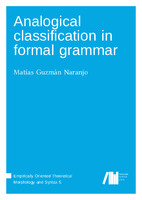Analogical classification in formal grammar
| dc.contributor.author | Guzmán Naranjo, Matias | |
| dc.date.accessioned | 2019-07-19 23:55 | |
| dc.date.accessioned | 2020-03-10 03:00:38 | |
| dc.date.accessioned | 2020-04-01T10:13:13Z | |
| dc.date.available | 2020-04-01T10:13:13Z | |
| dc.date.issued | 2019-07-01 | |
| dc.identifier | 1005206 | |
| dc.identifier | OCN: 1126153822 | en_US |
| dc.identifier.uri | http://library.oapen.org/handle/20.500.12657/24896 | |
| dc.description.abstract | The organization of the lexicon, and especially the relations between groups of lexemes is a strongly debated topic in linguistics. Some authors have insisted on the lack of any structure of the lexicon. In this vein, Di Sciullo & Williams (1987: 3) claim that “[t]he lexicon is like a prison – it contains only the lawless, and the only thing that its inmates have in commonis lawlessness”. In the alternative view, the lexicon is assumed to have a rich structure that captures all regularities and partial regularities that exist between lexical entries.Two very different schools of linguistics have insisted on the organization of the lexicon. | |
| dc.language | English | |
| dc.relation.ispartofseries | Empirically Oriented Theoretical Morphology and Syntax | |
| dc.subject.other | Linguistics | |
| dc.title | Analogical classification in formal grammar | |
| dc.type | book | |
| oapen.identifier.doi | 10.5281/zenodo.3191825 | |
| oapen.relation.isPublishedBy | 0bad921f-3055-43b9-a9f1-ea5b2d949173 | |
| oapen.relation.isFundedBy | b818ba9d-2dd9-4fd7-a364-7f305aef7ee9 | |
| oapen.relation.isbn | 9783961101863 | |
| oapen.collection | Knowledge Unlatched (KU) | |
| oapen.grant.number | 104859 | |
| oapen.grant.program | Language Science Press 2018 - 2020 | |
| oapen.identifier.isbn | 9783961101863 | |
| grantor.number | 104859 | |
| oapen.identifier.ocn | 1126153822 |

